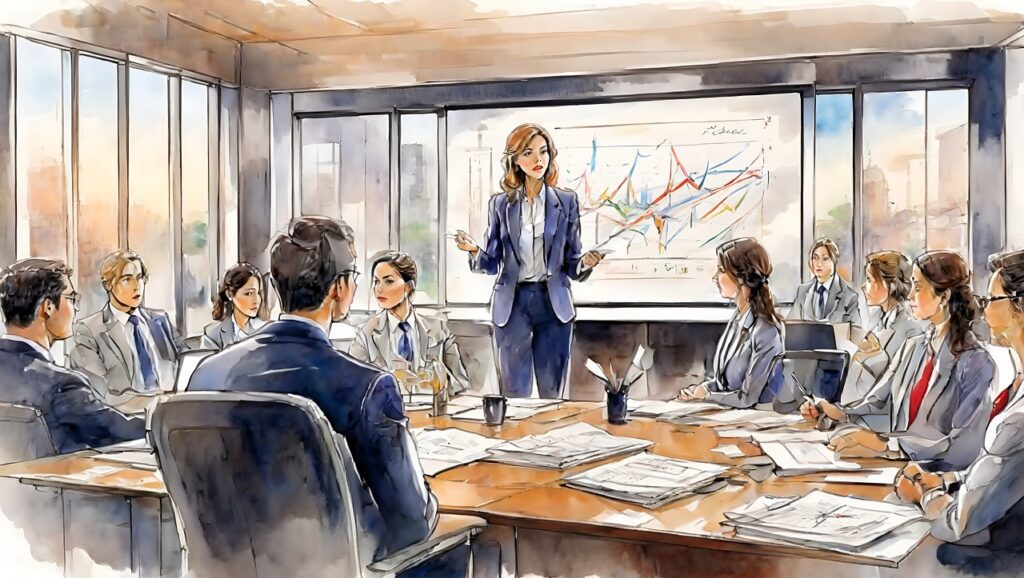Group discussions play a crucial role in promoting collaboration and creativity among team members. They provide an opportunity for individuals to share their opinions, ideas, and expertise, leading to more well-rounded decision-making. To ensure a successful group discussion, it is essential to employ strategies that encourage active participation and engagement from all participants. That’s where these effective phrases for group discussions come in handy.
Group Discussion: Tips and Techniques to Improve Participation
One effective technique is to create a supportive and inclusive environment where everyone feels comfortable expressing their thoughts. Encourage open-mindedness and respect for different perspectives. Additionally, establish clear guidelines for communication, such as allowing each person to speak without interruption and giving everyone an equal opportunity to contribute.
Active listening is another critical aspect of a productive group discussion. By actively listening to others, participants demonstrate respect and show that they value their peers’ opinions. This can be achieved by maintaining eye contact, nodding to show understanding, and paraphrasing or summarizing others’ points to ensure comprehension.

Key Phrases for Group Discussions: Enhancing Communication
In a group discussion, using effective phrases can help express opinions and ideas more clearly. By incorporating keywords such as “opinion,” “idea,” and “tip” into our conversations, we can ensure that our thoughts are conveyed accurately. For example, instead of simply saying, “I agree,” we can add depth to our response by saying, “I completely agree with your opinion because…”
Politeness is essential in a group discussion, especially when interrupting or seeking clarification. Instead of abruptly cutting someone off, we can use phrases like, “I’m sorry to interrupt, but I have a question about…” or “Could you please clarify your point on…” This allows for a smoother flow of conversation while respecting others’ contributions.
Furthermore, it is crucial to encourage others to share their thoughts and comments. Using phrases like, “What are your thoughts on this?” or “Does anyone else have an idea to contribute?” creates an inclusive atmosphere and invites everyone to participate actively.
Enhancing Idea Generation in Group Discussions: Techniques and Tips
Fostering a supportive environment for sharing ideas is vital in a group discussion. By using techniques and tips that encourage creativity and open-mindedness, participants can generate a wider range of ideas. Brainstorming is an effective strategy to unleash creativity and encourage participants to think outside the box. By creating a judgment-free zone and encouraging participants to share any idea that comes to mind, the group can explore new possibilities.
Expanding on others’ ideas is another valuable technique in idea generation. By using phrases such as, “Building upon what [Name] mentioned earlier…” or “I would like to add to [Name]’s idea by suggesting…” participants contribute to the discussion while acknowledging and valuing previous contributions.

The Role of Language in Group Discussions: Communicating in English
Clear and concise communication is essential in group discussions, especially when participants are communicating in English. Non-native English speakers may face challenges in expressing themselves with fluency and accuracy. However, by following a few tips, they can effectively convey their opinions, ideas, and directions.
First, non-native English speakers should focus on using simple and straightforward language. It is crucial to avoid complex sentence structures and unfamiliar vocabulary that may hinder understanding. By using keywords and phrases relevant to the topic, they can effectively communicate their thoughts.
Secondly, non-native English speakers should actively practice and improve their English language skills. Engaging in regular conversations, reading English literature, and listening to English podcasts can help build vocabulary and enhance fluency. Additionally, seeking feedback from native English speakers and participating in language exchange programs can provide valuable opportunities for improvement.
Lastly, non-native English speakers should remember that effective communication is not solely dependent on language proficiency. Active listening, body language, and non-verbal cues also play a significant role in understanding and being understood in group discussions. Non-native English speakers should focus on these aspects as well to ensure effective communication.
Active Listening in Group Discussions: Techniques for Engaging Discussions
Active listening is a fundamental skill that contributes to the success of group discussions. By actively listening, participants demonstrate respect for others’ opinions and show their commitment to understanding the topic at hand. Here are some techniques to engage in active listening during group discussions.
Firstly, maintaining eye contact with the speaker shows that you are present and attentive. It conveys interest and encourages the speaker to continue sharing their thoughts. Additionally, nodding in agreement or understanding helps reassure the speaker that their message is being received positively.
Paraphrasing or summarizing the speaker’s points is another effective technique. By rephrasing what the speaker said in your own words, you can ensure that you understood their message correctly. This also allows for clarification if there was any misunderstanding.
Using phrases to show engagement and encourage further discussion is also crucial. For example, saying, “I appreciate your perspective on this,” or “Could you elaborate further on that point?” encourages the speaker to share more and keeps the conversation flowing.

Constructive Commenting in Group Discussions: Providing Valuable Input
Providing constructive feedback and comments in a group discussion is essential for the growth and improvement of ideas. It is crucial to offer suggestions and alternative perspectives in a respectful and considerate manner.
When providing feedback, it is important to focus on the idea rather than the individual. By using phrases like, “I think it would be beneficial to consider…” or “Have you thought about approaching it from a different angle?” participants can contribute valuable input while maintaining a supportive environment.
Disagreements are bound to arise in group discussions, but they can be addressed respectfully. Instead of using confrontational language, phrases like, “I see where you’re coming from, but I have a different perspective” or “I understand your point, but have you considered…” allow for a constructive exchange of ideas without causing conflict.
Remember, the goal of constructive commenting is to provide valuable input and contribute to the discussion’s growth and development.
Confidence Building in Group Discussions: Overcoming Speaking Anxiety
Speaking in a group setting can be intimidating, especially for individuals who struggle with speaking anxiety or fear of public speaking. However, there are techniques that can help build confidence and overcome these challenges.
One tip is to prepare in advance. Familiarize yourself with the topic of discussion and gather relevant information. This will provide you with a sense of security and enable you to contribute confidently.
Another strategy is to practice speaking in smaller group settings before participating in larger group discussions. This allows you to gradually build confidence and become more comfortable expressing your thoughts and ideas.
Using phrases that convey confidence and assertiveness can also help boost your self-assurance. For instance, instead of saying, “I’m not sure, but maybe…” you can say, “In my opinion, based on my experience, I believe…”
Remember, building confidence is a gradual process, and it is essential to be patient and kind to yourself as you work towards overcoming speaking anxiety.

Direction and Flow in Group Discussions: Keeping the Conversation Going
Maintaining a smooth flow and direction in group discussions is crucial to ensure all participants remain engaged and the conversation progresses effectively. Here are some techniques to keep the discussion on track.
Firstly, it is important to establish clear objectives and goals for the discussion. This helps guide the conversation and ensures that everyone is working towards a common purpose. Setting a clear agenda at the beginning can also help keep the discussion focused.
Transitioning between topics smoothly is another aspect of maintaining direction in group discussions. Using phrases like, “Moving on to our next point,” or “Now that we have covered that topic, let’s discuss…” helps signal the transition and keeps everyone aware of the direction of the conversation.
Encouraging active participation is vital for maintaining a dynamic and engaging discussion. Using phrases like, “What does everyone else think?” or “Let’s hear from someone who hasn’t shared their thoughts yet,” invites quieter participants to contribute and ensures that everyone’s input is valued.
By incorporating these techniques and using appropriate phrases, the discussion can flow smoothly, allowing for a productive and inclusive conversation.
Conclusion: Effective Practices for Successful Group Discussions
In conclusion, group discussions are powerful tools for collaboration, creativity, and decision-making. By incorporating effective phrases, practicing active listening, providing constructive comments, building confidence, and maintaining direction, participants can enhance their group discussion experiences.
Remember, effective communication is the key to successful group discussions. Utilizing phrases that express opinions and ideas clearly, being attentive listeners, and providing constructive feedback contribute to a more inclusive and productive environment.
By implementing these practices, individuals and teams can foster a culture of open communication, encourage diverse perspectives, and ultimately achieve more successful and engaging group discussions. So, let’s start incorporating these tips and techniques into our next group discussion and keep the conversation rolling!


